 |
| By Ann Richards |
The
following short biographies are of
the ten most influential men in the
world of knitting. Who says that these
are the top ten? I do! And by what
authority do I make the choice? I
thought of it!
Childishness aside,
this is a purely academic exercise,
and I am well aware that my choices
might not be everyone's. In fact,
I would love to hear other nominations:
the small amount of research I did
to narrow my candidates to ten made
me realize how little I really know
about the history of knitting.
In deciding which
men to include, I took the meaning
of the word "influential"
at face value. Not all of the men
were or are knitters, and some of
them might not even have known about
their knitting legacy. This interpretation,
of course, leads to some odd choices,
but that makes it more fun, don't
you think? Looking at them as a group,
there are 3 military men, an iconic
author, three knitting instructors,
an artist, a prince, two members of
the peerage, four designers, a farmer,
and a fictional symbol. Makes for
an interesting group.
 |
HRH
The Prince of Wales
(Edward VIII)
(1894-1972)
The Prince made a big impression,
and not just by abdicating the
throne in order to marry American
divorcée Wallace Simpson.
The knitting world was less
interested in his personal life,
and more impressed with what
he was wearing. And, starting
in 1921, the Prince was wearing
Fair Isle sweaters.
Beginning with a gift from
a draper named James A. Smith,
the Prince began to wear Fair
Isle sweaters to golfing events,
during his globe-trotting public
relations trips, and even for
a portrait painted by John St.
Helier Lander.
According to the grand doyenne
of Fair Isle, Alice Starmore,
the Prince of Wales wearing
a Fair Isle pullover "was
undoubtedly the single most
important event in the commercialization
of Fair Isle knitting."
In the 1920s, Fair Isle sweaters
became so popular that most
Oxford and Cambridge students
owned one, and suddenly it seemed
that Fair Isle hats, gloves
and cardigans were seen everywhere.
|
|
Photo
courtesy Postcard
World
Alice Starmore's Book of
Fair Isle Knitting
by Alice Starmore. The Taunton
Press, Inc. Newtown, Connecticut,
1988.

|
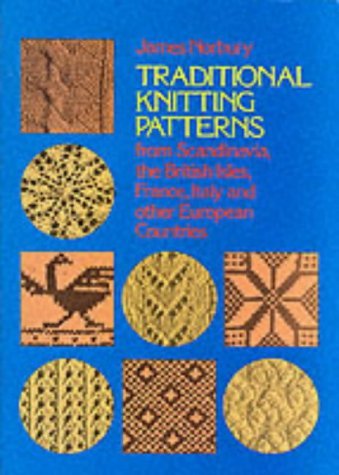 |
James
Norbury
(1904-1972)
James Norbury was a true Renaissance
man in the world of knitting.
He was a knitwear designer,
a television star on his own
BBC knitting show, author of
such books as The Knitter's
Craft,
Knit with Norbury,
Knitting is an Adventure
and
the classic Traditional
Knitting Patterns [at left],
still available today. He was
a knitting historian, knitting
teacher, and head designer and
spokesman for Patons.
With
his many knitting skills, enthusiasm
for the craft and colorful personality,
Bishop Richard Rutt, in his
book, A History of Hand
Knitting
asserts, "James Norbury
was the strongest single influence
in British knitting during the
25 years after the Second World
War."
Norbury
took his knitting seriously,
and insisted there was a right
and wrong way to do everything,
claiming, for example, that
needles should be 13 inches
long or more, the right one
should be tucked under the arm
and the left should do all the
work. He said of himself, "I
was a foolhardy lover who has
always been prepared to throw
his loyalty and devotion at
the feet of Mistress Knitting."
Hmmmm.
|
|
- A History of Hand Knitting by Bishop Richard Rutt. Interweave Press, Inc.,
1987.
- Traditional
Knitting Patterns from Scandinavia,
British Isles, France, Italy
by James Norbury. Dover Publications,
1973.

|
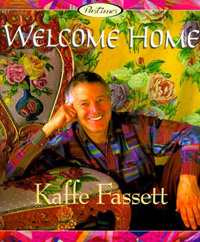 |
Kaffe
Fassett
(1937-)
Kaffe Fassett, whose name rhymes
with "safe asset,"
could be James Norbury's doppelganger.
Also a multitalented knitter,
Fassett is first and foremost
an artist. After learning to
knit from a stranger on a train,
Fassett applied his knowledge
of color and aesthetics to knitting
and in doing so built a knitting
empire.
An established teacher and
designer, Fassett, like Norbury,
publishes prolifically and hosted
his own knitting show on the
BBC.
Unlike Norbury however, his
emphasis is not technique, but
rather color, creativity and
variety. In fact, he occasionally
advises knitters to tinker with
traditional technique if it
increases efficiency or simply
makes sense. Still active in
the knitting community while
practicing other arts and crafts,
Fassett maintains a studio in
London, and launched the career
of Brandon Mably, another influential
man in the world of knitting.
|
|
- Brilliant
Knits: 25 Contemporary Knitwear
Designs from the Kaffe Fassett
Studio by Brandon Mably. Taunton
Press, 2001.
- Glorious Colors by Kaffe Fassett. Clarkson Potter, 1988.
- Kaffe's Classics:
25 Glorious Knitting Designs
by Kaffe Fassett. Taunton Press,
2000.
- Kaffe Fassett's
Family Album: Knitting for Children
and Adults by Kaffe Fassett, Zoe Hunt and Steve Lovi. Taunton
Press, 2000.
- Kaffe Fassett's
Pattern Library: Over 190 Creative
Knitwear Designs by Kaffe Fassett and Sally Harding. Taunton Press,
2003.

|
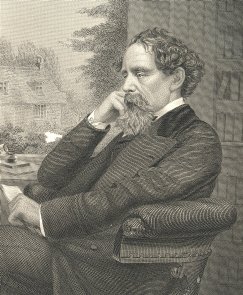
|
Charles
Dickens
(1812-1870)
Who is the
most famous fictional knitting
character in Western literature?
Madame Defarge, no doubt.
A creation
of Dickens' fertile mind, Madame
Therese Defarge appears in his
classic novel, A Tale of
Two Cities. As a leader of the Jacques during the French
revolution, she used pattern
stitches as a code and knit
a list of the upper class doomed
to die at the guillotine. According
to Rutt in his comprehensive
A History of Hand Knitting,
Dickens was inspired by the
"tricoteuses", women
who attended the National Convention
in which the fate of the unfortunate
rich was debated during the
French revolution, knitting
while they listened. Such a
macabre pastime earned them
a reputation as sadists, and
an archetypal evil character
was born in Madame Defarge.
This was a true testament to
Dickens' talent. He was able
to turn knitting, the frequent
symbol of loving grandmothers
and charming domesticity, into
an ominous, cruel, inhuman act.
|
|
Photo
courtesy Noel
Collection.
- A History
of Hand Knitting by Bishop Richard Rutt. Interweave Press, Inc.,
1987.
- A Tale of
Two Cities by Charles Dickens.
Penguin Books, reissue 2003.

|
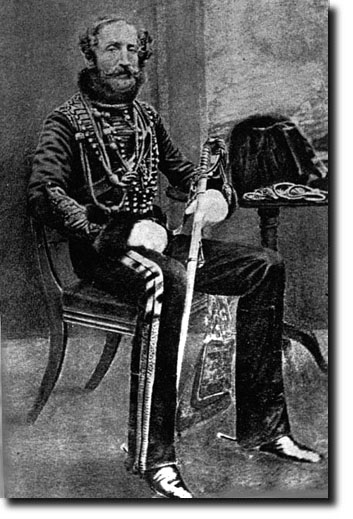 |
James
Thomas Brudenell,
7th Earl of Cardigan
(1797-1868)
The Earl of
Cardigan is described by various
web sites as "vain"
and "contentious"
(www.encyclopedia.com),
"foppish," "hopeless,"
"a notorious rake,"
(www.observergroup.net) while Cecil
Woodham Smith, in his book The
Reason Why,
calls Cardigan, "unusually
stupid," and "an ass."
Regardless
of his character flaws, the
Earl of Cardigan was a natty
dresser, and made sure that
the brigade he took charge of
in 1857 was well dressed, sporting
woolen button-down jackets.
Unfortunately,
due to a misunderstanding and
an apparent lack of common sense,
Cardigan lead that same well-dressed
brigade into a disastrous cavalry
battle against the Russians
at Balklava during the Crimean
war. Over half the men were
slaughtered, and the event was
immortalized in Tennyson's poem,
Charge of the Light
Brigade.
His
name is used today to describe a knitted
sweater that buttons down the front
similar to the original woolen jackets
worn by his ill-fated brigade.
|
|
Photo
courtesy British
Empire.
- The
Charge of the Light Brigade by Alfred Lord Tennyson. Goldencraft, 1964.
- The Reason
Why by Cecil Woodham Smith. Penguin Books, 1987.
www.encyclopedia.com
www.fashion-era.com/what_is_in_a_name.htm
www.observergroup.net
www.victorianweb.org/history/crimea/indivov.html

|
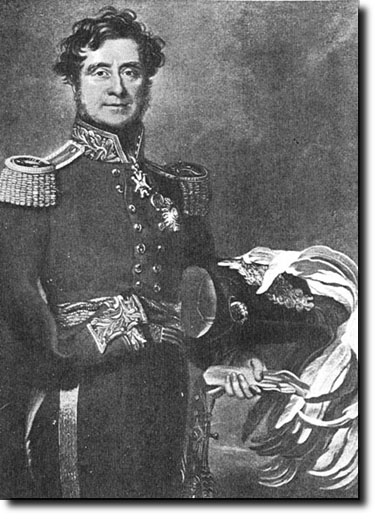 |
Fitzroy
James Henry Somerset, Lord Raglan
(1788-1855)
In one of
the great ironies of knitting
history, (if there are any)
the other namesake of a sweater
style, Lord Raglan, was also
involved in the battle described
in Charge of the Light Brigade. Fortunately, he was a comparably likeable man
who dedicated his life to the
military and Great Britain.
It just so happens that Lord Raglan was the one
who gave the Earl of Cardigan
the order that was misunderstood
and led to the near complete
massacre of the Light Brigade.
Some years before that, however, Raglan had his
right arm amputated following
damage it received at the battle
of Waterloo. His tailor then
designed a special short coat
for him with a diagonal sleeve
seam running from under the
arm to the neckline making it
easier for Lord Raglan to dress
himself. With this simple innovation,
a classic sweater shape was
invented.
|
|
Photo
courtesy British
Empire.
www.fashion-era.com/what_is_in_a_name.htm
www.victorianweb.org/history/crimea/indivov.html

|
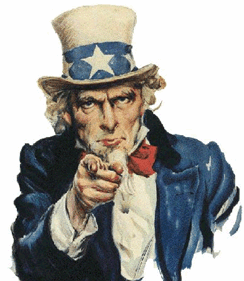 |
Uncle
Sam
(1776-)
All right,
it's a cheap choice, but there
is a reason. Actually, there
are several. First, in the last
100 years the most influential
events in convincing men and
boys to knit (and many, many
women for that matter) were
the World Wars. Governments
around the world, not to mention
the Red Cross, encouraged civilians
to assist in the war efforts
by knitting garments for the
troops. For example, in his
article, When
Knitting was a Manly Art,
Clinton W. Trowbridge fondly
remembers his years in elementary
school when he learned to knit
along with many other boys.
Second, during
the first half of the 20th century,
wars were primarily administrated
and fought by men, so it stands
to reason that there must be
a man somehow involved in leading
the knitting efforts, yes? How
about the head of the Red Cross?
Although the board of the Red
Cross was predominately male,
during WWII it was the lone
female on the board who organized
and encouraged the stateside
knitting efforts. The theme
of the campaign, however, was
"knitting for Sammy,"
a reference to Uncle Sam.
Third, if
we were to trace the roots of
the martial knitting efforts
back to the men who truly started
everything, we'd end up with
the Archduke Ferdinand and Adolf
Hitler on the list of most influential
men in knitting history. Uncle
Sam seemed like a better choice
to represent the overwhelmingly
male population that was knitting
and wearing knitted items during
those years.
|
|
- No Idle
Hands by Anne L. Macdonald. Ballantine Books, 1988.
- For the Love
of Knitting, Kari Cornell, ed. Voyageur Press, 2004.

|
 |
Eugene
Bourgeois
(contemporary)
Eugene and
Anne Bourgeois are the Lunt
and Fontaine, the Ball and Arnaz,
the Torville and Dean, of the
knitting world. In each of these
cases it's hard to see where
one partner leaves off and the
other one begins, but it is
perfectly clear that each individual
is talented in his or her own
right.
In the Bourgeois
case, while their collaborative
efforts built the Philosopher's
Wool company, it was certainly
Eugene's academic background
that influenced the company's
name (he has an M.A. in Pythagorean
mystical philosophy). According
to his description of their
journey toward founding a wool/yarn/knitting
business, it was Eugene's interest
in raising mushrooms, that led
to an interest in sheep dung
fertilizer, that led to an interest
in sheep, that led to an interest
in fair market prices for wool,
that led to producing yarn (that
would be a chain [stitch] effect.)
It was Ann's knitting that then
brought them full circle to
providing high quality yarn,
patterns, books, videos and
knitting lessons. In the process,
Philosopher's Wool has been
a moving force in reintroducing
beautiful, soft wool yarn dyed
in a variety of inviting colors;
nouveau Fair Isle designs, and
the "two-handed" stranding
techniques. Now an inveterate
knitter himself, Eugene's continues
to influence the knitting world
at trade shows, through publications
and at Philosopher's Wool home
base in Ontario, Canada.
|
|
- Fair
Isle Sweaters Simplified
by Ann and Eugene Bourgeois.
Martingale and Company, 2000.
www.philosopherswool.com

|
Izo
Matukawa
(dates unknown)
In her 2002 article on the history
of knitting, Yoshimi Kihara describes
the importance of Izo Matukawa on
Japanese knitting. Converted to Christianity
in the 1880s, Matukawa learned to
knit from a missionary. This was apparently
not uncommon. As western styles culture
became more popular during the late
1800's, many Japanese students learned
to knit in missionary schools. However,
according to Kihara, Matukawa took
the craft to another level. "To some
extent the beginnings of the Japanese
method of making hand knitting patterns
with charts can be traced all the
way back to [Matukawa]. It was he
who first thought of the idea of adapting
knitting patterns along the lines
of the markings used on canvas embroidery
patterns." In the mid 1800s, he led
a number of workshops to teach knitting,
and in 1986 Matukawa published Step
by Step Knitting Patterns.
www.knitjapan.co.uk

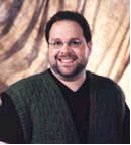 |
Barry
Klein
(contemporary)
I round
out the ten most influential
men in the world of knitting
with a man whose career is in
its early stages. There's no
doubt that Klein is making his
mark however; he's everywhere!
Barry Klein is the owner of
Trendsetter Yarns and is a past
president of the National Needlework
Association. He has designed
patterns for Vogue Knitting,
Interweave Knits, and Knitters
Magazine among others -- in
fact, one of his designs is
on the cover of the current
issue of Vogue Knitting.
His
books include The Ultimate Knitted
Tee and Knitting with Novelty
Yarns, and The Knitters Template, all co-authored
with Laura Militzer Bryant.
He once knit for 36 hours straight,
making sweaters for Wes Craven's
Nightmare on Elm Street. Klein
makes frequent appearances at
conferences, knitting cruises
and the like. A simple Google
search turns up 8,490 references
(and that excludes Barry Klein
the realtor!) including mentions
of him in the knitters chat
rooms, in an article about Lily
Chin, a reference to his appearance
on Shay Pendray's PBS
Show, his free patterns, and
on and on.
|
|
- A Knitter's
Template- Easy Steps to Great
Fitting Garments by Laura Militzer
Bryant & Barry Klein. Martingale
& Co., 2003.
- Knitting with Novelty
Yarns by Laura Militzer Bryant
and Berry Klein. Martingale
and Company, 2001.
- The Ultimate Knitted
Tee by Laura Militzer Bryant
and Berry Klein. Martingale
and Company, 2004.
http://www.knittinguniverse.com/xrx/athena/prosdetail.php?ID=1858
www.trendsetteryarns.com

|
|
|   Ann
Richards is a professional writer who teaches
knitting as a hobby, although the line between
profession and hobby tends to blur considerably. Ann
Richards is a professional writer who teaches
knitting as a hobby, although the line between
profession and hobby tends to blur considerably.
|
| images © as
credited above. Text © 2005 Ann Richards.
Contact Ann |
|

